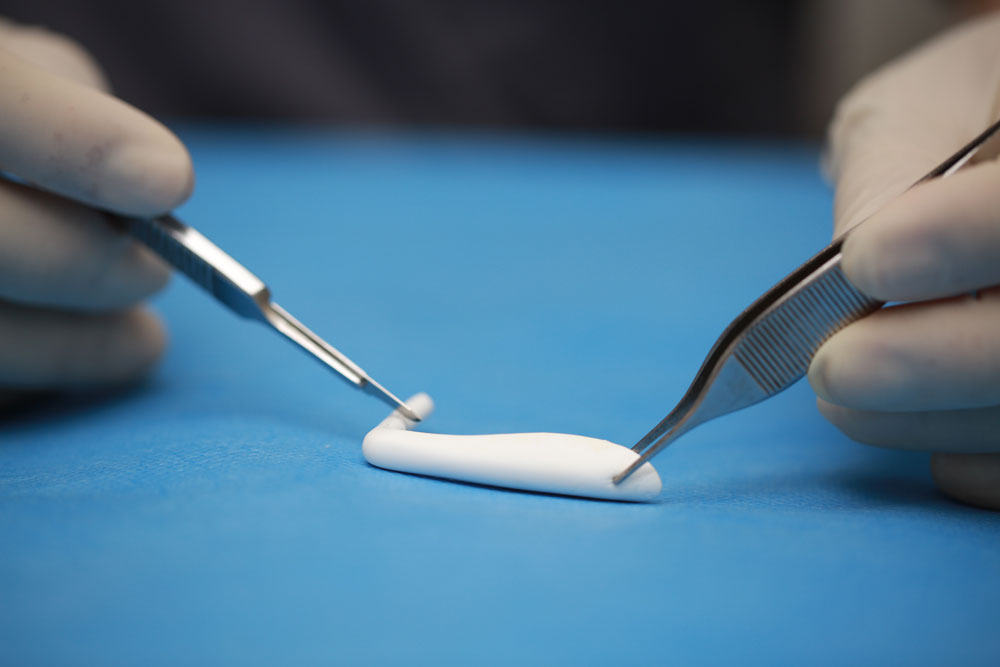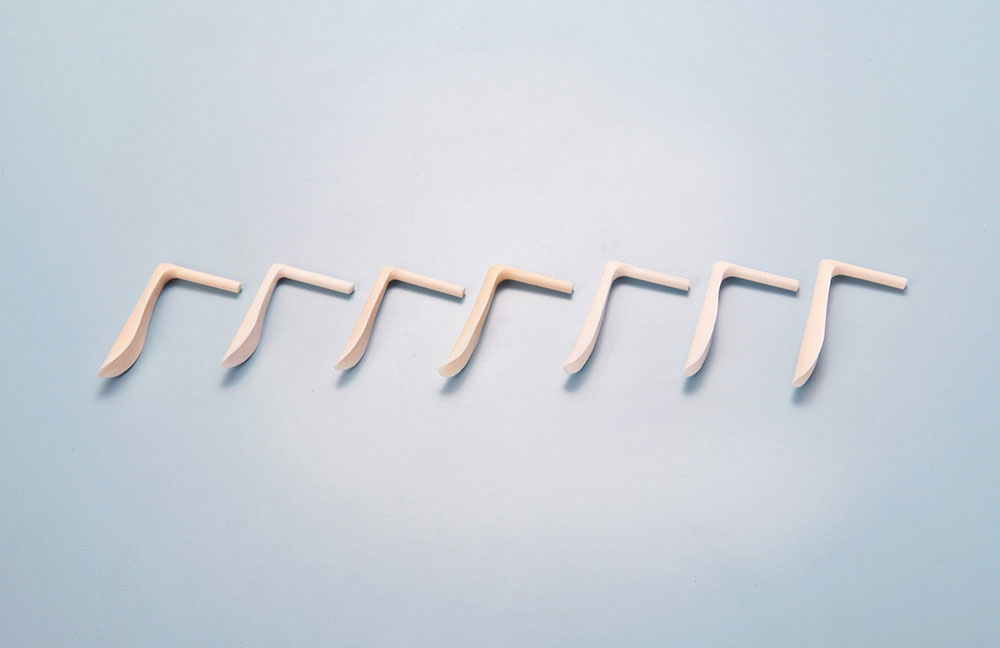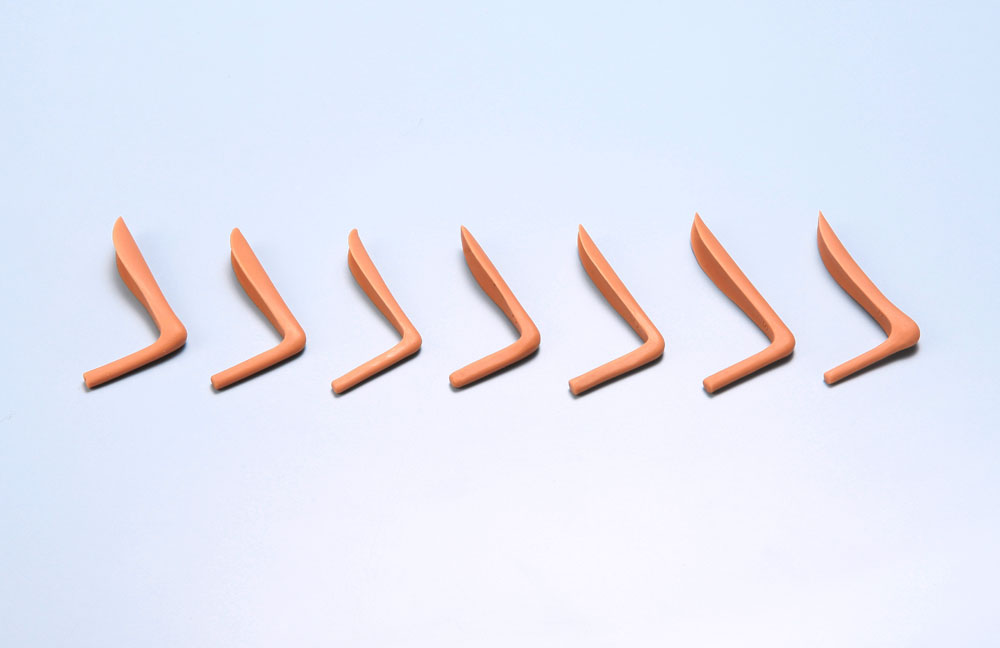Surgical Concept
Rhinoplasty is an ancient plastic surgery and is one of the most common facial esthetic surgeries among Orientals. Nasal implants have been developed from the earliest ivory tooth, traditional hard silicone, and flake Gore-Tex to the latest soft form silicone (Korean Bistool implant) and composite Sili-Tex (silicone–Gore-Tex composite), which not only continuously improve the safety of surgeries but also lower the occurrences of complications. In addition to advances in material technologies, the surgical method and concept of rhinoplasty have undergone changes, evolving from the traditional surgery of simple nasal bridge augmentation using an L- or I-model nasal implant to the currently open (Korean-style) two- or three-section rhinoplasty that needs to be combined with nasal tip cartilage transplant and sculpting besides bridge augmentation. Moreover, the artificial materials can be completely replaced by autologous costal cartilage in fully costal cartilaginous rhinoplasty. Such diverse materials and surgical options have covered almost all problems of rhinoplasty and allow physicians to make more accurate and customized changes in light of different conditions in individual patients. Therefore, currently, surgeons performing rhinoplasty focus on the elevation of the nasal bridge or tip and take into account the expectations and requirements of patients and also select the most suitable surgical method and material for patients, which is generally the key to surgical satisfaction. Considering this, Dr. Chuang attaches great importance to preoperative consultation and communication. Patients may put forward any model or photo that they desire, and he will be very glad to hear you out and give you the most proper suggestions after evaluating your original conditions.
Dr. Chuang emphasizes the coordination between the nasal bridge and tip in rhinoplasty. Because Asians generally have broad faces and prominent mouths, the nasal bridge looks relatively flat and low; therefore, excessively emphasizing proportions similar to Westerners would make the nose appear too obvious and protrusive (like a Grecian nose), but a blind simulation of Korean esthetic proportions always results in excess nasal tip tilting or nostril exposure (upturned nose), which may not be favored and accepted by local patients. Therefore, Dr. Chuang’s open rhinoplasty integrates different concepts and essences by making regional adjustments in the length and angle of the nasal tip and nostril level to meet the requirements of most Chinese. Additionally, considering the common nose types of Taiwanese such as a bulbous nose, a wax apple-shaped nose, a snub nose, or an short nose and nostril exposure, Dr. Chuang excels in integrating multiple surgical procedures and materials by applying columella incision and open nose sculpting to artistically manipulate the autologous septal cartilage, auricular cartilage, and autologous fascia in complex intranasal structures. The safest method to completely release skin tension to achieve natural nasal tip elongation is only by the radical reconstruction and adjustment of the nasal tip cartilage. Despite such complexities, open rhinoplasty takes a long time, and its results are unrivaled compared with those of the conventional one-section or simplified (intranasal incision) two-section rhinoplasty for patients who hope to redress all defects in one rhinoplasty. It is also a preferred option for those who are ineligible for rhinoplasty or have complicated nasal problems.
Apart from the coordinated sculpting of the nasal bridge and tip, nasal bone reduction and deviation correction should not be neglected in modern rhinoplasty. Dr. Chuang completely improves the broad and flat nasal bridge and obtuse nasal tip commonly seen in local citizens by employing the effective nasal bone reduction (also called corrective osteotomy of the nasal bone) and concurrent appropriate nasal tip and alar reduction and also simultaneously rectifies latent problems such as nasal bone deviation to set upright and narrow the nasal bridge, thus sculpting a more exquisite and delicate nose. Despite these complexities, such surgeries are the secret of delicate rhinoplasty results and deserve to be recommended for patients with high esthetic criteria.
In spite of his abundant experience in open rhinoplasty, Dr. Chuang still harbors great enthusiasm and motivation to try and surpass patients’ expectations. Dr. Chuang not only sculpts diverse appearances suitable for individual proportion but also provides highly customized surgery to reproduce outstanding rhinoplasty results. This signifies Dr. Chuang’s insatiable self-challenge and is the best reward that he hopes to present to his patients!

Dr. Chuang’s expertise including maximizing the results of rhinoplasty by wisely use of materials, making the surgery outcome truly esthetic.
Surgical Characteristics
Open (Korean-style) Rhinoplasty
Open (Korean-style) rhinoplasty refers to the surgical technique rather than the material used. This surgery is the safest and most effective method for correcting a flat nose, a bulbous nose, and an upturned nose. It was first used for reconstructing traumatic nasal deformities but has started to be commonly used in simple cosmetic rhinoplasties in the recent decade by Korean physicians, because of which it derives its name. Conventional open rhinoplasty involves making an open incision at the bottom of the columella to facilitate the complete relaxation and elongation of intranasal connective tissues and cartilages and make the nasal tip skin more distensible, which helps correct numerous tricky nasal shapes (such as a snub nose or an upturned nose). It is also called open rhinoplasty as the incision is exposed in the nose. Another characteristic of this surgery is the change from the traditional single nasal implant prosthesis to a two- or three-section structure, where the augmentation of the nasal bridge still uses an artificial nasal implant such as silicone or Sili-Tex (Chimera) and Gore-Tex prostheses, while the patient’s nasal septum or auricular cartilage is utilized to remodel the length and angle of the nasal tip. In this way, it effectively avoids the thinning of the nasal tip skin due to prosthesis compression or the risk of prosthesis protrusion and also effectively sustains long-term stable results, which are suitable to fix the short tip or tight skin problems that are common among local patients. Moreover, open rhinoplasty realizes alar cartilage repair inside the nasal tip and centralized stitching, which effectively reduces the section volume of the nasal tip and customizes various tip shapes or angles based on patients’ requirements. For some patients undergoing revision rhinoplasty or nasal reconstruction, Dr. Chuang provides additional advanced open rhinoplasties including nasal tip reinforcement using autologous fascia, nasal columellar elongation, alar composite graft, or even autologous or allograft costal cartilage rhinoplasty.
WiSH clinic currently offers silicone implants, Chimera composite implants (e-PTEF), Core-Tex prostheses, or autologous and homologous (allograft) costal cartilage as the material for open rhinoplasties. Material properties and surgical details need to be recommended and confirmed after Dr. Chuang’s consultation. If the patient wishes to have a customized nose, open rhinoplasty is the unique technique that fulfills this dream.
Diversified Nasal Implant Selection
The height and width of the nasal bridge are mainly dependent on the patterns and size of the emplaced prosthesis (nasal implant); therefore, selecting the proper implant for each individual challenges the doctor’s esthetic experience. Currently, all nasal implants offered at WiSH clinic are legal materials approved by the Ministry of Health and Welfare. We prepare a full range and series of various nasal implants in stock so that patients can freely make choices based on Dr. Chuang’s suggestions and requirements.
Silicone Nasal Implant
Refined from a traditional or old-style silicone implant, this modern implant is relatively thin and has an ergonomic design. They are available in an I or L shape as well as various sizes. The advantages of this implant are its easy emplacement and removal and the low price, but the drawbacks are the relatively high risks of infection or foreign body reaction (approximately 5–7%). If emplaced in an inappropriate position, it shows dislocation or looseness easily. Silicone implants may also present capsular contracture or deformities after prolonged use, therefore they are rarely selected by local patients. Generally, these nasal implants are indicated for patients with a narrow bridge base or those who prefer an expected slim and a highly defined nasal bridge as the result.
Link : Silicone nasal implant provided by Implantech
Sili-Tex (Chimera) Composite Nasal Implant
A Sili-Tex (Chimera) composite implant is a new-generation nasal prosthesis produced in the US and is also called a “hard” Gore-Tex nasal implant. It is also available in models I or L. It is composed of hard silicone as the internal scaffold, which is enveloped by Gore-Tex (ePTEF) at a thickness of approximately 1 mm at the outer layer. Therefore, the surface in contact with the human body is Core-Tex rather than silicone. This composite design not only redresses the drawbacks of capsular contracture or foreign body reaction but also has the high biocompatibility and tissue adhesiveness of Gore-Tex, which provides solid and non-deformable nasal bridge support and distinctly elevates the safety and durability of rhinoplasty than the traditional laminar (soft) Gore-Tex material, thus amounting to one of the best prosthesis at present. Moreover, because the coated Gore-Tex surface makes the implant thicker and wider, the bridge shape resembles the congenital bone structure that does not appear exceedingly slim or sharp like the silicone implant, so the results are relatively harmonious and natural. If the prosthesis is to be removed in the future, it is easily taken out via a unilateral intranasal incision instead of cutting the columella incision again like what the traditional laminar Gore-Tex prosthesis requires, and this is surely highly reparable.
Link : Implantech ePTEF composite implants
Bistool Beak-shaped Nasal Implant
It is a refined soft silicone nasal implant produced in Korea and is also available in models I or L. As its appearance is designed like a curved beak, it is also called a beak-shaped nasal implant. Its advantages are the numerous models and sizes (up to 45 types for the entire series), which satisfy the various structures and requirements of a majority of patients, and the time it saves for the modification of nasal implants during the surgery, while its drawback is the utilization of silicone material as the primary component; therefore, foreign body reaction, rejection, infection, or capsular contracture and dislocation may still occur in certain cases. Additionally, because its design is aimed to intentionally sculpt a mild nasal bridge curvature, the implant possibly makes the nasal tip too upturned, which conflicts with local patients’ requirements for the downward compression or elongation of the nasal tip, thus becoming unsuitable for remodeling the projected nose or extending the nasal tip.
Link : Korean Bistool silicone implant
Laminar Gore-Tex Prosthesis
It is a soft single ePTEF material and comes into shape after layers of stacking. The available thicknesses are 1, 2, 4.5, and 6 mm, and physicians select the appropriate thickness for scissoring and stacking in light of the patient’s nasal structure conditions during the operation; it has the highest plasticity and customization degree among all nasal implants. However, its drawbacks include a relatively long operation time and slightly higher risks of postoperative infections than the hard Chimera nasal implant. Besides, the soft Gore-Tex prosthesis may present crooking, unevenness, or shrinkage over time as it is prone to structural changes due to the behavior of its material in the body. Its long-term stability is also inferior to that of the Chimera prosthesis, and an open incision on columella needs to be made for further removal or even small modifications, which makes the revision surgery relatively more complex. Nowadays, the laminar Gore-Tex prosthesis has been mostly replaced by the Chimera nasal implant, and its applications are mainly limited to the reinforcement of the support or height of another nasal implant or the glabellar augmentation in three-section rhinoplasty.
Link : Implantech Gore-Tex products


We provide a complete selection of nasal implants for patients with all types of conditions and demands.
As there are numerous options for nasal implants, patients are generally unable to have a correct cognition based on superficial or biased information. Therefore, the responsibility of Dr. Chuang is to help patients choose appropriate materials and apply different prostheses to meet their diverse requirements for achieving the esthetic and functional results of rhinoplasty.
Comparison of nasal implant
| Common silicone nasal implant (US made) | Bistool silicone nasal implant (Korean made) |
Sili-Tex composite nasal implant (Chimera) | |
|---|---|---|---|
| Model selection | Model I or L | Model I or L | Model I or L |
| Structural composition | Full-layer hard silicone | Full-layer Soft silicone | Hard silicone as the internal scaffold and Gore-Tex as the outer layer |
| Emplacement method | Intranasal or columellar open incision | Intranasal or columellar open incision | Intranasal or columellar open incision |
| Application scope | Simple or open (Korean-style) rhinoplasty | Simple or open (Korean-style) rhinoplasty | Simple or open (Korean-style) rhinoplasty |
| Plasticity | High | High | Relatively low |
| Stability | Common | Common | High |
| Infection probability | Common | Common | Relatively low |
| Capsular contracture | Probable | Probable | No |
| Bridge light reflection (white shadow) | Probable | Probable | No |
| Removal method | Intranasal incision | Intranasal incision | Intranasal incision |
| Price | Low | Low | Relatively high |
Application of Composite Materials
This indicates the integrated applications of rhinoplasty materials and is aimed to remedy the defects of a single prosthesis by multiple materials. The operation is divided into procedures at the nasal bridge and tip. For the augmentation of the nasal bridge, Dr. Chuang utilizes the laminated or sandwiched concept, which involves heightening the nasal bridge by applying two types of implants (such as a composite Chimera nasal implant and a laminar Gore-Tex prosthesis) and correcting the size constraint problem with a single material to satisfy the requirements of patients with exceeding nasal bridge collapse, traumatic saddle nose, or those demanding a subjectively extremely projected or high nose and to customize various nasal shapes. Nevertheless, for the selection of composite materials, the compatibility between the two materials should be taken into consideration, so it is better to choose prostheses with similar textures to avoid rejection or inflammation. For example, a laminar Gore-Tex prosthesis and a Chimera nasal implant are a safe match because their contact surfaces are mainly made of Gore-Tex; therefore, increasing the height of a Chimera nasal implant by a laminar Gore-Tex prosthesis or augmenting the nasion with a laminar Gore-Tex prosthesis in three-section Chimera rhinoplasty seldom incurs foreign body rejection; Clinically, this is the safest and most widely used model of composite materials.
In addition, for patients with an exceedingly short nasal tip or an upturned nose, Dr. Chuang frequently utilizes nasal septal cartilage combined with auricular cartilage to elongate the tip shape or sculpt the supratip projection, thus boosting the support and stability of the tip structure by the cartilage mass harvested from both sites and avoiding appearance changes arising a long time after rhinoplasty. Patients with very thin skin or inadequate cartilaginous strength also choose variable autologous dermal fat graft to plump up the tip skin or use a polydioxanone (PDS) absorbable plate or even allograft (donor rib) implantation to assist columellar strength and support, which not only obviates concerns of the occurrence of an exceedingly pointed, firm tip sensation or the unnatural cartilage shadow after rhinoplasty due to thin skin but also plumps up the nasal tip fat and extends the thickness of tip skin, which is conducive to the long-term stability of results. This advanced nasal tip sculpting based on the different types of materials belongs to a primary application of composite rhinoplasty, and Dr. Chuang offers specific surgical plans with multiple material options after evaluating the necessity in each individual.
Nasal Bone Reduction and Correction
The width or alignment of the congenital nasal bones is critical to rhinoplasty results but is also most likely to be ignored by physicians and patients. The role of the nasal bones in rhinoplasty is the foundation of the nasal prosthesis. If the foundation is misaligned, the augmented nasal bridge also becomes deviated. Further, if the foundation is too wide, the nasal bridge supported by the prosthesis appears thick and falls short of beautiful esthetics. Therefore, reaching a preoperative diagnosis and confirming nasal bones condition are highlighted by Dr. Chuang. Generally, there are three nasal bone problems in rhinoplasty cases. The most frequently seen is nasal tubercle (also called dorsal hump or humpy nose), indicating the hard osteophyte prominent at the superior one-third section of the nasal bridge but actually is the protuberance of the nasal bone and cartilage suture, which is shaved in rhinoplasty. The second most frequently seen is nasal deviation, which is usually caused by uneven facial skeletal development and occasionally by septal deviation or traumatic impacts. It is complicated by nasal septal deviation in some patients, and bone reduction (corrective and lateral osteotomies) should be conducted to restore the deviated bones to the midline before the augmentation of the nasal bridge. The third condition is exceedingly wide nasal bones, frequently accompanied with a broad or hypertrophic nasal tip. Treatment emphasizes on making rhinoplasty results more exquisite and beautiful and entails bone reduction to compress the bilateral nasal bones toward the nostrils medially before rhinoplasty. Nevertheless, the reduction degree should be measured to avoid complications such as nasal obstruction or dyspnea. In WiSH clinic, nasal bone correction is mostly conducted under general anesthesia and is frequently performed along with open (Korean-style) rhinoplasty to attain optimal results.
